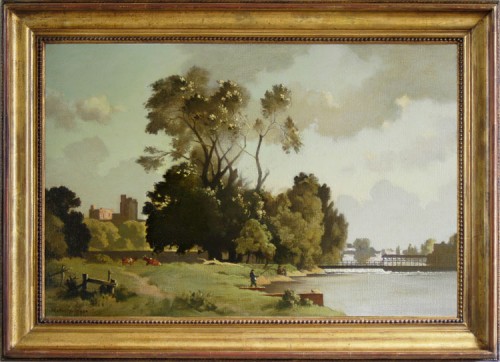Important Artistic Movements: Romanticism
After having recently looked at the Baroque era of art, it is now, only pertinent that we explore the early 19th century movement of Romanticism and how this influenced the world of art – providing a basis for the transitions that continued to happen into the 20th and 21st centuries.
“Romanticism is precisely situated neither in choice of subject nor in exact truth, but in a way of feeling.” – Charles Baudelaire
Key Elements
Although the style of the Baroque era was starting to show signs of a huge change across the world, Romanticism went that step further. With the world becoming a more enlightened and knowledgeable place, artists were beginning to reflect this in their art – choosing more natural subjects and exploring the imagination more deeply.

BERTRAM NICHOLLS The weir at Windsor
Important Artists
The Romantic Movement saw the careers of many well known artists including:
- William Blake
- John Constable
- Thomas Cole
- Eugene Delacroix
- J.M.W Turner
This era saw the Romantic Movement in literature as well as art and featured the likes of Edgar Allen Poe, John Keats and William Wordsworth.
Influence on the Art World
As with any other art movement, Romanticism had a huge and lasting impact – not just on the art world, but on the ever changing culture. Romantic art opened up the way for new subject matters to be explored, particularly landscapes which had been rarely portrayed before.
As mentioned above, the impact of this movement didn’t just affect paintings either, with literature, music and sculpture also becoming heavily influenced by the movement too.
British poets such as William Wordsworth and Samuel Taylor Coleridge are heavily associated with the Romantic Movement and were both involved in the Utopian social movement following the French Revolution.
With regards to music, Mozart, Haydn and Beethoven have been referred to as the three “Romantic Composers” by E.T.A Hoffman in 1810. The term “Romanticism” in music generally refers to the period between 1820 to 1910.
Romanticism and Nationalism
The Romantic Movement focused greatly on the development of folklore and local traditions and customs through art.
However, one of the lasting legacies of this movement has been the assertion of nationalism, which featured heavily in the work of Johann Gottfried von Herder.
Romantic nationalism changed dramatically following the French Revolution. This event and the following Napoleonic nationalism and republicanism inspired many other nations, both in their art and in their way of thinking; they believed that self determination and a knowing of national unity were the reasons behind the French victory in battle.
Here at Mark Mitchell, we enjoy seeing how such art movements inspire and impact on the outcome of other artist’s work. As we have a variety of British paintings for sale, you may be surprised at how many of these works of art are heavily influenced by art movements such as Romanticism.


